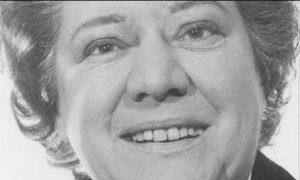Kathleen Jones Death
Kathleen passed away on October 13, 2010 at the age of 88.
When did Kathleen Jones die?
October 13, 2010How old was Kathleen Jones when died?
88
Kathleen Jones Birthday and Date of Death
Kathleen Jones was born on April 7, 1922 and died on October 13, 2010. Kathleen was 88 years old at the time of death.
Birthday: April 7, 1922
Date of Death: October 13, 2010
Age at Death: 88
Kathleen Jones - Biography
Kathleen Jones, who has died aged 88, was the leading historian of the mental health services. Kay was responsible for three great studies: Lunacy, Law and Conscience (1953), Mental Health and Social Policy (1960) and Mental Hospitals at Work (1962, written with Roy Sidebotham). She was one of the few responsible for establishing teaching and research in social policy in British universities, and founded the department of social policy and social work at the University of York in 1965.She was concerned that beliefs about the causes of the wide forms of behaviour captured by the umbrella term "mental health" could all too easily lead to a situation where, in her own words, "by default ... a group of (often) very damaged and unhappy people will not get the help they need". She expressed anxiety about the gap between theory and practice, and between policy in Whitehall and delivery in the local community or on the ward. She wrote about how mental health policy was implemented; about how organisational structures help or hinder innovation; and how best to support staff through often turbulent changes.Born Kathleen Savage in London, she was the daughter of a lorry driver and a dinner lady. She was brought up on a large council estate and won scholarships to the North London Collegiate school and Westfield College, part of the University of London (then based in Oxford in the early years of the second world war), where she edited the student paper Oxford Socialist. She queued at Her Majesty's Stationery Office to buy the Beveridge Report, which proposed social welfare reform, when it was published in 1942. As a lecturer in postwar reconstruction for the Workers' Educational Association, she introduced the report to her extramural classes.In 1944 she married a fellow student, Gwyn Jones, who was an army chaplain. On being demobbed he became a chaplain at a large mental hospital in Lancashire and Kay worked as its volunteer public education lecturer. She became fascinated with the history of these institutions. No one had written in detail about them and yet she found there was a mass of documentary evidence. After some difficulty finding a supervisor she began a doctorate and in due course obtained a post as a research assistant at the University of Manchester. Gwyn was recalled to the army during the Malayan emergency; she lectured part-time there and wrote the first study of Malaysian social services.AdvertisementReport this adPaid for by MorningFinanceForget Social Security if you Own a Home (Do This)If you own a home, you should read this. Thousands of homeowners did this yesterday, and banks are furious! Do this now before it's...See MoreReturning to the University of Manchester as a lecturer, she continued with her research on mental health and became known as "Jones the Mental". In 1961 Enoch Powell, then minister of health, announced the closure of large psychiatric institutions. Kay thought this was nothing short of asset-stripping by the NHS – mental-health patients were to be returned to local authorities in large numbers, with inadequate funding, no research base and no staff retraining. She campaigned against the plan with a mass of publications and speeches. Powell sent her handwritten letters expressing his annoyance.When Lord James of Rusholme, the first vice-chancellor of the University of York, headhunted her to be "director of social work training", she told the appointing committee that social workers should be educated – not trained like seals – and anyway she was not a social worker. She was appointed professor of social administration in 1965. The university was new with little space, so Kay started recruiting staff and students from a student bedroom. By the time she retired, in 1988, the department had become one of the largest and most successful of its kind in Britain.No one had much time for social policy. She was a key player in the establishment of the subject, writing a survey in 1965, The Teaching of Social Studies in British Universities; serving 10 years as the social policy representative on the university grants committee; and editing the International Library of Social Policy.She continued to write on mental health and, although she was neither a social worker nor a psychiatrist, she served as chairman of the Association of Psychiatric Social Workers and was elected an honorary fellow of the Royal College of Psychiatrists. She was a devout member of the Church of England, serving on two lengthy national commissions: the Archbishops' commission on church and state and the Archbishops' commission on marriage. She was a member of Lord Gardiner's committee on Northern Ireland (terrorism and human rights), which involved visiting republican detainees in the Maze Prison. She was delighted that she contributed to the end of detention without trial. She also served as chair of the Mental Health Act commission dealing with patients' complaints all over the north of England. These included a practising vampire in Rampton who insisted on being interviewed alone.AdvertisementReport this adIn retirement she continued to be productive, writing a textbook, The Making of Social Policy in Britain (2001). Her interests had moved on to the saints and, after editing The Poems of St John of the Cross (1993), she contributed to Butler's Lives of the Saints (1999) and wrote Women Saints (1999) and Who Are the Celtic Saints? (2002). She said that brushing away all the myths was an absorbing occupation for a woman who did not knit and could still shin up library ladders. Her final work was Challenging Richard Dawkins (2007), a combative reply to aggressive atheism.Combative was perhaps her hallmark. She was a fighter – for resources for her department; for the social gospel of her church; and for psychiatric patients. She was also a formidable teacher and supervisor. I know – she supervised my PhD and I succeeded her at York.Gwyn died in 1976 and their son Stephen in 1993.• Kathleen Jones, scholar of social policy, born 7 April 1922; died 13 October 2010








